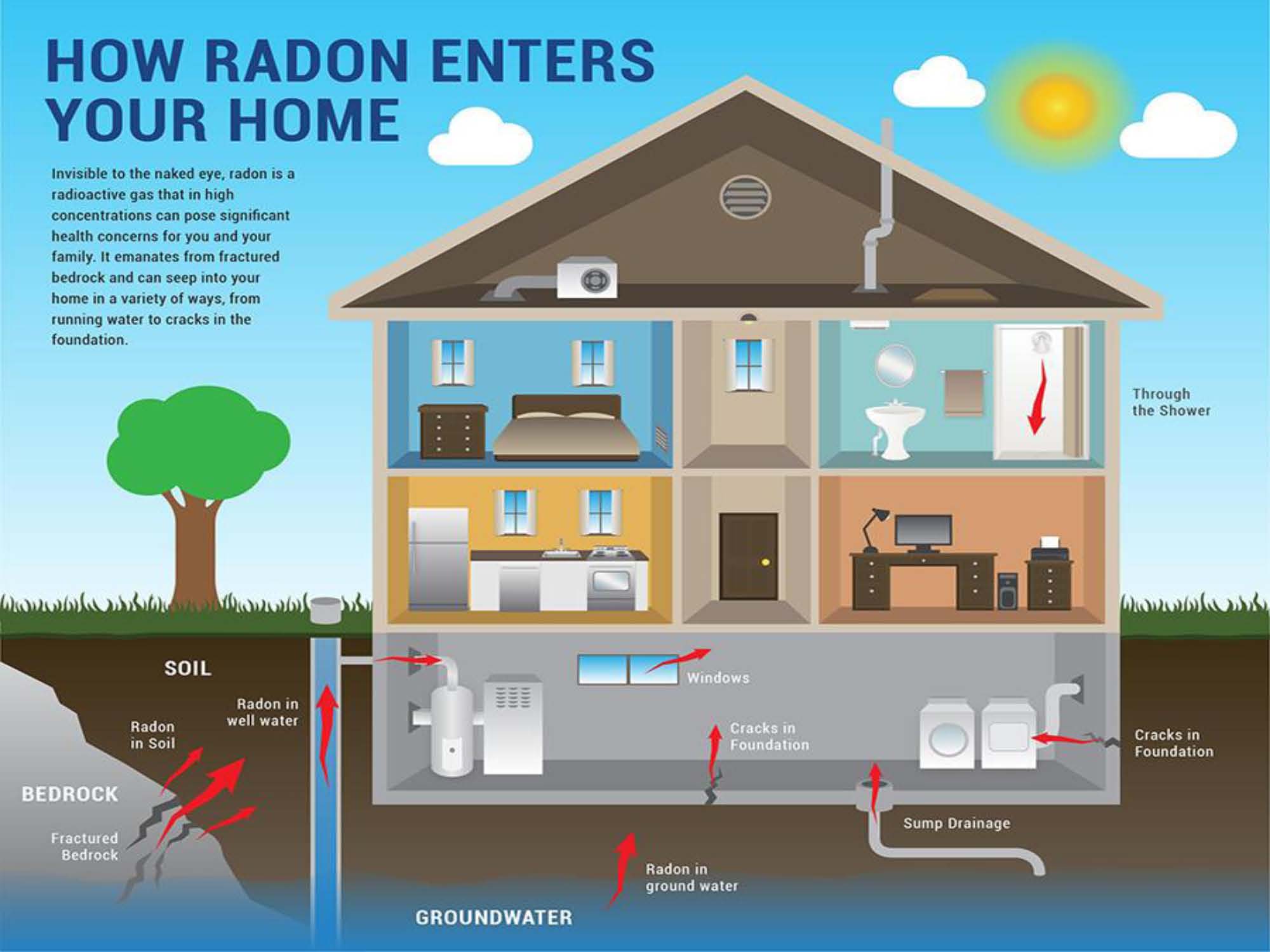Radon is produced by uranium in the soil that decays and creates a gas. While radon gas is all around us, it is not usually a problem because of very low concentrations in the atmosphere. When uranium decays under a home the gas seeps into the home through foundation cracks and plumbing lines. Improved building techniques and insulation intended to provide energy-efficient homes have the unintended side effect of trapping the gas inside the home. For more information visit: EPA Radon. See here specific radon information by area: Virginia, and Maryland.

Lead poisoning causes permanent neurological damage and is particularly toxic to children and pregnant women. The effects include IQ reduction, learning disabilities, hyperactivity, and behavioral problems. Household dust from lead-based paint is the most common cause of poisoning. For more info visit: EPA lead
Asbestos was installed in many buildings as a fire retardant and as insulation. It was also used as backing on vinyl sheet flooring. The mineral fibers in the asbestos become a health hazard when disturbed, and may cause cancer and lung scarring. Formerly, asbestos was removed from buildings when it was found. Current practice is to encapsulate it and not disturb it, if possible. If old vinyl flooring is to be removed, an asbestos specialist may be required. EPA Asbestos
Formaldehyde is used in pressed wood products made using adhesives that contain urea-formaldehyde (UF) resins. Hence, it is prevalent in homes and can cause watery eyes, burning sensations in the eyes and throat, nausea, and difficulty in breathing in some humans exposed at elevated levels. For more info visit: EPA Formaldehyde
Polybutylene (PB) is a plastic resin that was used for water supply pipes for about 20 years, starting in 1978. It was cheap, easy to install, and was substituted for copper pipe in nearly 25% of all homes built during that period. Use of the product typically saved the builder up to $600 per home. The pipes are gray or white with a dull finish. PB was also used for underground water mains, which are usually blue, gray, or black. The problem with the pipes is that they often sprout leaks inside walls or ceilings, requiring extensive repairs and a complete re-plumbing of the house. Mold can result as a secondary health risk. General Poly Information
Every day, we are exposed to electromagnetic radiation (EMR), whether it comes from televisions, cell phones, computers, or power lines. Some studies have shown that EMRs can cause cancer and leukemia. Wherever there is electric power there are EMRs. Because there is a public perception of danger, the presence of high voltage electric transmission lines may affect the market value of property, requiring disclosure.
Mold is not a plant or animal. It's a type of fungus, and its spores are present in the air we breathe, both indoors and out. We see it on bread or cheese that we keep too long. If we are not good housekeepers, we can see it on the tile grout in the shower. If mold is present in a house, particularly vacant homes, a 'musty' odor is often detected. Mold is often called 'mildew. ' The most common indoor molds are Cladosporium, Penicillium, Aspergillus, and Alternaria. Perhaps the worst type of mold is Stachybotrys Chartarum, also called Stachybotrys Atra. It's also called 'black mold 'because of its greenish-black color. EPA Mold

"What causes mold in a building? If the spores land in an excessively moist area of our homes it will grow, sometimes very rapidly. Roof leaks, plumbing leaks, condensation, water infiltration, or flooding are common causes of moisture. Wood, drywall, carpeting, and other building materials that become damp can become moldy. Newer materials like pressed wood or particle board hold moisture for longer periods and are particularly susceptible to mold. Mold is not always a health problem. If a person is sensitive to molds, the symptoms may be nasal stuffiness, eye irritation, or wheezing. More severe reactions can include fever and shortness of breath. Mold spores can become a greater problem because of the 'tight 'construction techniques used today.
The Centers for Disease Control and Prevention (CDC) have received reports about serious effects of toxic mold, such as pulmonary hemorrhage or memory loss, but says the reports are rare, and that links between mold and these serious illnesses have not been proven. CDC Mold
Arsenic in water has no smell, taste or coloration when dissolved in water, even at high concentrations. Thus, only water quality testing can determine its presence. Arsenic has been classified by the U.S. Environmental Protection Agency (EPA) as a human carcinogen (cancer causing agent). Long term exposure to arsenic has been linked to cancer, cardiovascular disease, immunological disorders, diabetes and other medical issues. Where drinking water is rusty colored and has arsenic, the rusty particles may concentrate the arsenic. Thus, do not consume rusty colored water. For more information, visit the EPA Arsenic - or - Agency for Toxic Substances & Disease Registry
Chinese Drywall with potential risks is made of waste from coal-fired plants. The material that wouldn't burn was recycled into the drywall instead of being taken to a landfill. The drywall was used in 2004 and 2005 because there was a high demand for building materials at the time and this was available and cost-effective. Could you have Chinese drywall? See how you answer the following questions:
Does your home have a strong smell (a sulfur or rotten egg-type smell)?
Since moving into the house, has someone in the family experienced symptoms of severe allergies, nose bleeds, or upper respiratory problems? If that person leaves the home for an extended period of time, do these symptoms disappear?
Do you have corroded copper coils in your air conditioner or are the coils black?
Are your stove and/or refrigerator breaking down quickly?
Are your silver jewelry and/or silver wedding plates and/or flatware tarnishing quickly?
Are your mirrors turning black?
Do you have KNAUF written on the back of your drywall? Go to your attic and look at the back side of the drywall for Knauf. This is the manufacturer's ID, which identifies it as the drywall in question. Chinese drywall is thinner and lighter than typical drywall.
Don't waste money on lab testing. If you went over the checklist above and suspect you have Chinese drywall, call an environmental testing company to come out and verify it. It can be verified for legal purposes without lab tests. Health effects are unknown, and there is not enough data on the actual chemical compounds to make a determination. For more information select from the following governmental entities Consumer Products Safety Commission, and FTC for testing for defective drywall.

